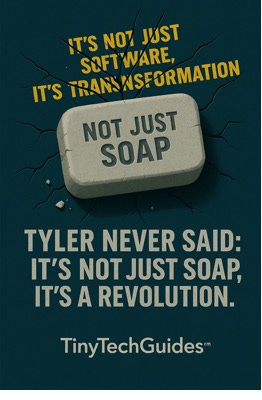Punctuation Pandemonium: When AI Content Goes Wild
The linguistic patterns that expose bot-generated copy
The third blog in a series discussing the great enshittification of the written word
AI’s addicted to punctuation. Every sentence gets colons for professionalism, em dashes for drama, and question marks for curiosity. These are the quintessential hallmarks of "bot-generated" content. Do you think this happens to save the LLM service providers' tokens and, therefore, money? Who knows. The only thing I know is that it doesn’t read like it’s written by a human.
I made this up, but I guarantee you've seen something just like it on a website, ebook, or whitepaper.
"Our platform delivers: unmatched performance, seamless integration, and revolutionary insights—transforming how teams collaborate—while providing: real-time analytics, customizable dashboards, and enterprise-grade security. It's not just software: it's your competitive advantage—designed for the modern workplace."
Twelve punctuation marks in 33 words spanning two sentences. That’s certainly not human writing, it's punctuation gone wild!
We see this pattern everywhere in AI content. As I explored in "Spotting AI junk words: Why AI still can't write like humans," AI reveals itself through predictable linguistic tics. ChatGPT used to love the word "delve," but now I think it’s gotten over that one. Early on, we couldn’t count how many times it popped up in AI-generated content. It was supposed to add depth, but it didn’t. It felt empty.[1] Don’t worry, new hollow words and phrases have quickly come and taken their place. Similar to the “delve syndrome”, these same patterns apply to punctuation. More marks, more problems.
The punctuation addition
Cervantes wrote 900 pages of Don Quixote without needing dramatic pauses every other sentence.[2] The absurdity of tilting at windmills spoke for itself.
For some reason, AI treats every sentence like a William Shatner Star Trek monologue. You know, the familiar, "Captain's... log... stardate... 2267... we have... encountered... a strange... new... phenomenon." Of course, that was his signature style, lots of dramatic pauses that didn’t belong.[3] In the end, I suppose it worked out for him.
Colons have become universal emphasis tools. "Our device offers: mystery and power, and its mystery is exceeded only by its power." Does that one ring a bell? That’s a riff on the Continuum Transfunctioner from Dude, Where's My Car?[4]
Em dashes are pervasive and flow like water. Every dependent clause gets wrapped in dashes, creating unnecessary drama where none belongs.
The "It's not X, it's Y" formula is another classic feature of bots. "It's not just software, it's a transformation." Chuck Palahniuk never needed formulaic structures in Fight Club.[5] Tyler Durden cut through BS directly. He never said, "It's not just soap, it's a revolution."
A 2024 study by Reinhart et al. proves this pattern. AI-generated text produces "right-branching adverbial clauses," pushing adverbs to awkward sentence endings.[6] Combined with excessive punctuation, these patterns create unmistakable bot signatures.
Who cares
The problem extends far beyond marketing copy. Scientific American warned that robotic writing assistants have infiltrated academic publishing, producing "technically accurate" content that feels hollow due to repetitive phrasing.[7] When AI content floods professional communications, credibility suffers, and trust erodes.
I’m sure you’ve seen the impact on business firsthand. Sales teams forward materials that all read the same way. Many customers tell us they can't differentiate between vendor messages. Lost opportunities, missed connections, and ignored content follow.[8] If that’s the result, why did you create it in the first place?
It’s not a mystery, but top-performing content shares three common elements: specific problems buyers face right now, data from actual implementations, and experience-based recommendations.[9] Did you notice that excessive punctuation and formulaic structures are not part of the mix?
Look at the difference:
AI version: "Our innovative solution—leveraging cutting-edge technology—delivers: unparalleled performance, seamless integration, and measurable results—transforming how businesses operate."
Human version: "We built software that actually works."
The difference is obvious.
What to do about it
Count the colons and em dashes in your last blog post. If there are more than three total, you've got punctuation pandemonium, not punctuated equilibrium.
Make ruthless cuts. Israel Kamakawiwoʻole's simple ukulele version of "Somewhere Over the Rainbow" has more impact than any over-produced remix with seventeen instruments.[10] The power was always in his voice, not the production.
Write like you're explaining something to someone who’s important to you. Use punctuation when grammar requires it. "The panda eats, shoots and leaves" versus "The panda eats, shoots, and leaves" matters.[11] Whatever you do, don't use punctuation for artificial emphasis.
Anthony Burgess created an entire slang language in A Clockwork Orange. When Alex said something was "real horrorshow," you knew exactly what he meant.[12] Now that’s an authentic voice!
What's next
Treat AI text as a first draft. Look for overused words like "innovative" and remove junkwords that add no value.[13] The same applies to punctuation. Every mark should earn its place.
Your readers are busy and generally scan; if it’s interesting, they’ll pause and read. Unnecessary punctuation is distracting and makes things hard on the eyes and ears. Every gratuitous colon becomes a speed bump, every forced emphasis mark gives them reason to click away.
Companies with clean, direct writing get better responses. Those that sound robotic get ignored.
"To colon or not to colon, that is the question: Whether 'tis nobler in the mind to suffer the slings and arrows of outrageous punctuation, or to take arms against this sea of em dashes, and by opposing, end them?"
Count your marks, cut the excess, and let your words rather than symbols create emphasis.
Your readers will thank you.
Next up: The "humanizer" workflow giveaways. When AI tries to sound casual and creates the uncanny valley of content marketing.
What's the most punctuation-heavy copy you've seen lately? Share it in the comments—I promise not to judge your company's website.
About David Sweenor
Books: Artificial Intelligence | Generative AI Business Applications | The Generative AI Practitioner’s Guide | The CIO’s Guide to Adopting Generative AI | Modern B2B Marketing | The PMM’s Prompt Playbook
Founder of TinyTechGuides, David Sweenor is a top 25 analytics and AI thought leader and influencer, international speaker, consultant and advisor, and acclaimed author with several patents. He is a product marketing leader, analytics practitioner, and specialist in the business application of AI, ML, data science, IoT, and business intelligence.
With over 25 years of hands-on business analytics experience, Sweenor has supported organizations including Alation, Alteryx, TIBCO, SAS, IBM, Dell, and Quest, in advanced analytic roles.
Follow David on Twitter @DavidSweenor and connect with him on LinkedIn https://www.linkedin.com/in/davidsweenor/.
Need help with PMM? Let me know.
[1] Sweenor, David. "Spotting AI junk words: Why AI still can't write like humans." TinyTechGuides, November 11, 2024.
[2] Cervantes, Miguel de. Don Quixote. 1605-1615.
[3] Shatner, William. Performance style analysis, Star Trek: The Original Series. NBC, 1966-1969.
[4] Leiner, Danny, director. Dude, Where's My Car? 20th Century Fox, 2000.
[5] Palahniuk, Chuck. Fight Club. W. W. Norton & Company, 1996.
[6] Reinhart, Alex, et al. "Do LLMs write like humans? Variation in grammatical and rhetorical styles." arXiv, 2024.
[7] Stokel, Chris. "AI Chatbots Have Thoroughly Infiltrated Scientific Publishing." Scientific American, 2024.
[8] Sweenor, David. "Stop Blending In: Creating Content That Actually Matters." TinyTechGuides.com, February 3, 2025.
[9] Ibid.
[10] Kamakawiwoʻole, Israel. "Somewhere Over the Rainbow." Facing Future, 1993.
[11] Truss, Lynne. Eats, Shoots & Leaves: The Zero Tolerance Approach to Punctuation. Gotham Books, 2003.
[12] Burgess, Anthony. A Clockwork Orange. William Heinemann, 1962.
[13] Sweenor, David. "Escaping Generative AI Mediocrity." TinyTechGuides.com, April 16, 2024.



